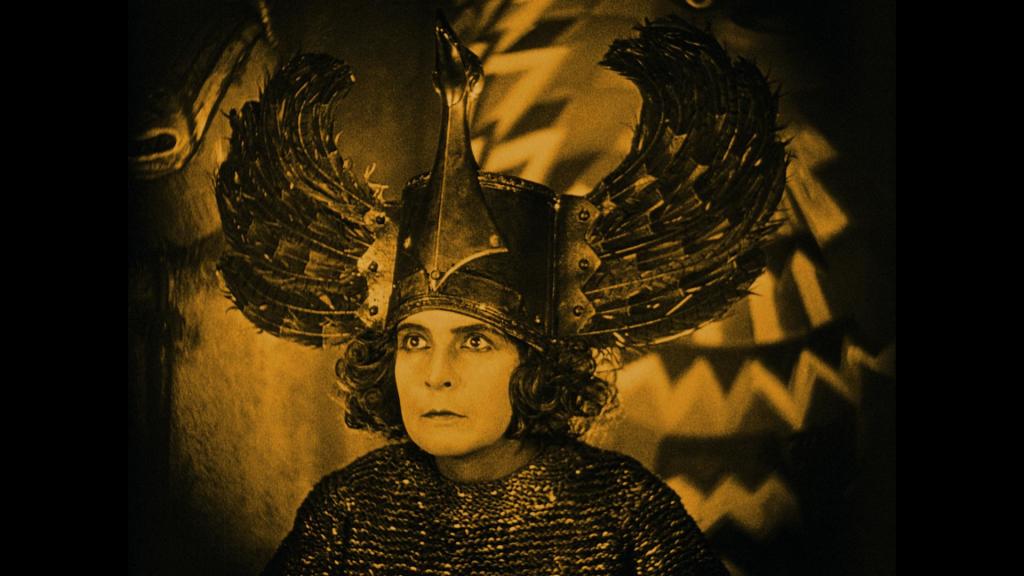Die Nibelungen: Siegfried
 |
| Hanna Ralph in Die Nibelungen: Siegfried |
Kriemhild: Margarete Schön
Brunnhild: Hanna Ralph
Siegfried: Paul Richter
King Gunther: Theodor Loos
Hagen Tronje: Hans Adalbert Schlettow
Mime / Alberich: Georg John
Die Nibelungen: Kriemhild's Revenge
 |
| Margarete Schön in Die Nibelungen: Kriemhild's Revenge |
Queen Ute: Gertrud Arnold
King Gunther: Theodor Loos
Hagen Tronje: Hans Adalbert Schlettow
King Etzel: Rudolf Klein-Rogge
Slaodel: Georg John
Director: Fritz Lang
Screenplay: Fritz Lang, Thea von Harbou
Cinematography: Carl Hoffmann, Günter Rittau, Walter Ruttmann
Art direction: Otto Hunte, Karl Vollbrecht
Costume design: Paul Gerd Guderian, Aenne Willkomm
Music: Gottfried Huppertz
Fritz Lang's two-part epic, based on the Middle High German Nibelungenlied, will confuse anyone who knows the story only via Richard Wagner's Ring cycle: There are no Rhinemaidens or gods or Valkyries, nothing of Siegfried's parentage, and, since it lacks gods, consequently no Götterdämmerung. It consists of two films, Siegfried and Kriemhild's Revenge, that tell the story -- parts of which will be familiar from the final two operas in Wagner's cycle -- of how Siegfried slew the dragon and bathed in its blood, becoming invincible except for one spot on his back that the blood failed to touch, then killed the dwarf Alberich and took possession of a magic net that renders him invisible. He travels to Burgundy, where he wins the hand of the beautiful Kriemhild by helping her brother, King Gunther, subdue the warrior maiden Brunnhild. But Siegfried is killed after Gunther's advisor, Hagen, tricks Kriemhild into revealing his vulnerable spot. Brunnhild kills herself and Kriemhild vows revenge on the whole lot, which in the second film she accomplishes by marrying King Etzel, aka Attila, and provoking war between his Huns and the Burgundians. Lang tells the story with an eye-filling blend of tableaus, set-pieces, and scenes swarming with bloody action, concluding with a spectacular fire in which the Burgundians are trapped in Etzel's castle. The performances are pretty spectacular, too. Richter plays Siegfried as a muscular young goof ensnared by fate, Ralph is a formidable Brunnhild, and Schön modulates from naïve to terrifying as Kriemhild. But it's the production design by Otto Hunte and the costuming by Paul Gerd Guderian that lingers most in the memory. The production evokes late 19th- and early 20th-century book illustrators like Arthur Rackham and Walter Crane, but also the stark hieratic figures of Byzantine mosaics, especially Kriemhild, who becomes more powerfully static as the film progresses. Much has been written about the way the film fed into the heroic German myth that was co-opted by the Nazis, especially since the screenwriter, Thea von Harbou, Lang's wife at the time, later joined the party. (Lang, whose mother was Jewish, left Germany in 1934.) In fact, the Nazis sanctioned only the first half, Siegfried, after they came to power. Kriemhild's Revenge, with its depiction of the corruption of power and its nihilistic ending, didn't suit their purposes.